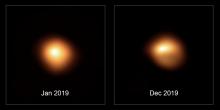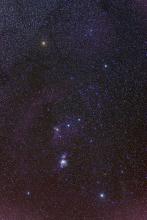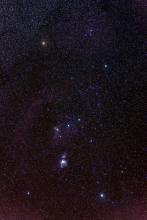Listen to today's episode of StarDate on the web the same day it airs in high-quality streaming audio without any extra ads or announcements. Choose a $8 one-month pass, or listen every day for a year for just $30.
You are here
Betelgeuse
Betelgeuse has lived a short but spectacular life — and it’s almost over. Within the next hundred thousand years or so, it should blast itself to bits as a supernova. Even then, it’ll leave an amazing corpse: a neutron star.
Betelgeuse marks the shoulder of Orion the hunter. The constellation is in the east and southeast at nightfall. It forms a rectangle of bright stars with a short line of three bright stars in its middle — Orion’s Belt. The belt aims straight up from the horizon in early evening. Betelgeuse is to the left of the belt.
Betelgeuse shines bright orange. That color indicates that its surface is thousands of degrees cooler than the Sun’s.
That “coolness” is only skin deep, though. Deep in its core, Betelgeuse is tens of millions of degrees hotter than the Sun. The core probably is “fusing” helium atoms to make carbon. That process is much hotter than the reactions taking place in the Sun. It produces tremendous amounts of radiation, which inflate the star’s outer layers like a giant balloon. Betelgeuse is so puffy that, if it took the Sun’s place, it would engulf the four inner planets — including Earth — and push toward the next planet, Jupiter.
As the star’s outer layers expanded, they got thinner and cooler, making them look orange. But because Betelgeuse is so big, it’s quite bright, even though it’s probably 550 to 600 light-years away — the bright shoulder of the hunter.
More tomorrow.
Script by Damond Benningfield






